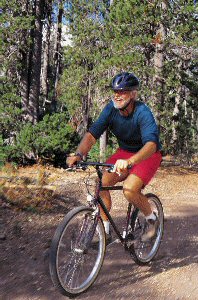

Success Stories > Alberta Environment: Active Transportation Makes Sense
At Alberta Environment, promoting active commuting is part of walking the talk. For years, the department has participated in Commuter Challenge. 
Commuter Challenge is a national initiative that challenges employees to leave the car at home and chalk up environmentally friendly kilometres. Leaving the car at home can also encourage people to do more physical activity.
But Commuter Challenge occurs during Environment Week, a supremely hectic time for Alberta Environment staff. So the department has moved its Commuter Challenge to September, a time that meets staff rhythms.
“In September, families are back from holidays, kids go back to school and the idea is for parents to ‘get back on the bus’ as well,” says Michelle Casorso, who has led previous Commuter Challenge efforts at Alberta Environment.
Organizers hope to promote a change in habits while the days are still reasonably long and the weather is fairly mild. As Michelle says, “Timing is probably the most essential thing for us, and it’s a challenge because there’s only a short window before winter.”
Alberta Environment in Brief
Size: 800 permanent employees.
Mandate: Manage the use of Alberta's diverse landscapes to sustain a healthy environment, a prosperous economy and strong communities.
Challenges: Multiple offices across the province, with just a few employees in some spots.
Success also depends on an effective team and a user-friendly system. Fortunately, Alberta Environment has an active Office Ecology team, a grassroots initiative aimed at making sure the department practises what it preaches.
Office Ecology has team leaders in many offices who are happy to distribute Commuter Challenge information and collect kilometre tallies. Participants only need to report their commutes to a team leader at a nearby desk, who will funnel the numbers to the closest Office Ecology representative.
“It’s a two-tiered process, which is a nice way to do it,” Michelle says. “The information comes from a person’s mouth rather than e-mails, and people know they have someone they can go to who knows what’s happening.”
The federal government incentives for active transportation include tax credits for buying transit passes and for enrolling children under 16 in certain physical activity programs.
By going it alone, Alberta Environment no longer has access to prizes offered through the national Commuter Challenge. But the department’s education group has partnered to fill that gap with incentives and prizes. “And of course you still get to brag about being top team in the department,” Michelle points out.
To identify winners, the team created a system that awards the most points per kilometre to the most active forms of transportation. “People who walk or cycle or rollerblade tend to travel less far, so just adding up kilometres gives people who were busing a huge advantage,” Michelle says. “We were trying to even the keel a bit.”
Management support for this and other healthy lifestyle initiatives is strong, thanks in part to a Deputy Minister and executive director who wholeheartedly champion such causes.
Inter-branch rivalry can also spur participation. “It encourages and motivates employees to join in doing something fun for the office. And because green commuting is really something our department values, it also reinforces that perspective,” Michelle says.
Staying Well at Alberta Environment: A Summary of Initiatives
- Learning and Wellness Account: To help staff keep healthy, each employee can spend $500 a year on career development and/or physical fitness activities (and is strongly urged to use those funds). Some employees purchase gym memberships, others go to fitness classes or do sport training and some buy home fitness equipment.
“I love my learning account. I’ve used mine for karate and scuba diving lessons — I use it a lot.”
Michelle Casorso, program evaluation analyst, Alberta Environment
Work/life balance: Managers understand the need for employees to balance work with the rest of life and do their best to model that approach.
-
Flex time and telecommuting: As long as the organization’s needs are met, staff can arrange their work schedules around personal needs, including physical activity. Part-time telecommuting works for some, allowing them to support both personal requirements and the environment by working from home rather than driving to work.
-
Participating in external events: Alberta Environment participates in Corporate Challenge, SummerActive and other external events. Staff members are encouraged to organize teams and activities, developing their leadership skills through extracurricular activities.
-
Recognition and encouragement: Active employees are saluted in the staff newsletter and encouraged in their individual and group activities. Many employees participate in charitable runs and marathons for various causes.
-
Facilities: Downtown Edmonton offices are equipped with bike racks, and some buildings have shower facilities. Onsite space is sometimes available for employee-coordinated fitness activities. For example, at least one group of employees uses an available boardroom for an onsite yoga class over the lunch hour.
-
Employee role models: Physically active staff members share their passions with colleagues. Cyclists have been known to run volunteer bike tune-ups and clinics during Clean Air week and invite guest speakers from the City of Edmonton to share great bike routes and other tips. Some employees also carpool to work (www.carpool.ca helps find matches) and exchange tips for taking advantage of programs that encourage active and responsible lifestyles.